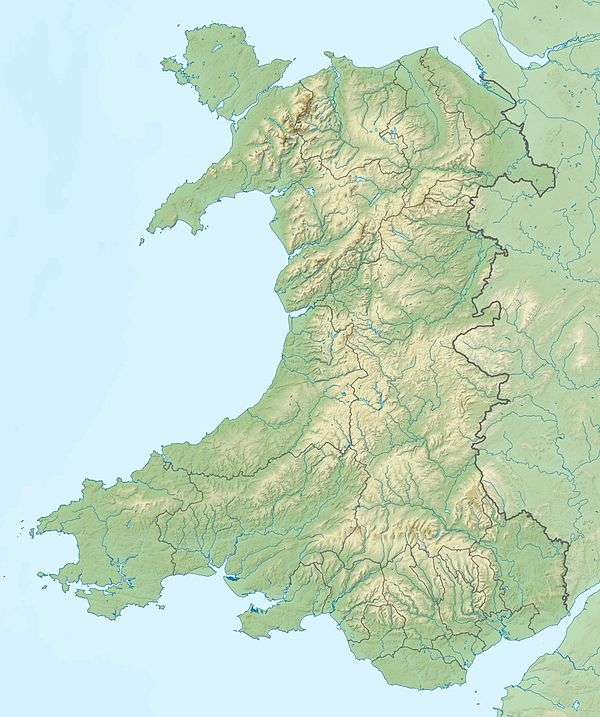Holyhead Breakwater Lighthouse
.jpg) The Lighthouse on Holyhead Breakwater | |
 Wales | |
| Location |
Holyhead Anglesey Gwynedd Wales United Kingdom |
|---|---|
| Coordinates | 53°19′51″N 4°37′09″W / 53.330898°N 4.619268°WCoordinates: 53°19′51″N 4°37′09″W / 53.330898°N 4.619268°W |
| Year first constructed | 1873 |
| Automated | 1961 |
| Construction | limestone |
| Tower shape | square tower |
| Markings / pattern | white tower with a broad black band in the upper part, white lantern |
| Height | 19 metres (62 ft) |
| Focal height | 21 metres (69 ft) |
| Light source | main power |
| Range | 14 nautical miles (26 km; 16 mi) |
| Characteristic | Fl (3) G 10s. |
| Admiralty number | A5174 |
| NGA number | 5476 |
| ARLHS number | WAL-011 |
| Managing agent |
Stena Lines[1] [2] |
The Holyhead Breakwater Lighthouse stands on the Holyhead Breakwater outside the Welsh port of Holyhead, Anglesey.
History
The structure, which was completed in 1873, was most likely designed by Victorian civil engineer, John Hawkshaw, after he took control of Holyhead harbour works in 1857.[3] The lighthouse was the last major building completed on the breakwater.[4]
The three-storey black and white tower, unlike many contemporary lighthouses, is square.[3] It measures 22.25 feet (6.78 m) on each side, is 63 feet (19 m) high and rests 70 feet (21 m) above the high-water mark.[4] It has chamfered angles and a stepped plinth set on an oval platform on the breakwater.[3] A square design was chosen because it made the living quarters more comfortable.[4] Much of the original living accommodation remains intact inside.[4]
The tower's external features include a roll-moulded string-course projecting above the first floor level. There is also a moulded cornice which supports a walkway around a circular glassed-housed light. The tower is surmounted by a weathervane and finial.[3] The enclosed fresnel lens creates a light with a range of 14 mi (12 nmi; 23 km).[3][4] The lighthouse is considered architecturally important because it forms part of the ambitious Victorian engineering works to create "harbours of refuge" throughout Great Britain.[3]
In the 19th century, packet ships approaching Holyhead in the fog would be warned by a bell operated from the lighthouse. In the late 1870s this was supplemented with rockets which would complement the gun fired from the fog warning station on North Stack, Anglesey.[5]
The lighthouse was manned until November 1961 when it was automated. Among the last keepers in the 1950s were Arthur Burgess and David John Williams. The latter later became a speaker for Trinity House giving talks on the service.[4] Like most other lights in Gwynedd, it is now operated from Trinity House's Holyhead Control Centre.[3] Today the upkeep of the lighthouse is the responsibility of Holyhead port authority, which is operated by Stena Line.[4]
Gallery
 The Breakwater seaward from the land end
The Breakwater seaward from the land end End of the Breakwater and Lighthouse
End of the Breakwater and Lighthouse Lower level carried the breakwater railway
Lower level carried the breakwater railway The Lighthouse
The Lighthouse The light was fully automated in 1961
The light was fully automated in 1961
References
- ↑ Holyhead Breakwater The Lighthouse Directory. University of North Carolina at Chapel Hill. Retrieved 1 June 2016
- ↑ Holyhead Breakwater Light Lighthouse Explorer. Retrieved 1 June 2016
- 1 2 3 4 5 6 7 Hague, D. B. edited by S. Hughes (1994). Lighthouses of Wales, Their Architecture and Archaeology. Royal Commission on the Ancient and Historical Monuments of Wales. ISBN 1-871184-08-8.
- 1 2 3 4 5 6 7 Denton, A., & Leach, N. (2008). Lighthouses of Wales. Landmark Publishing Ltd. ISBN 978-1-84306-459-6.
- ↑ Renton, Alan (2001). Lost Sounds: The Story of Coast Fog Signals. Dundurn Group. p. 185. ISBN 1870325834.
External links
| Wikimedia Commons has media related to Holyhead Breakwater Lighthouse. |